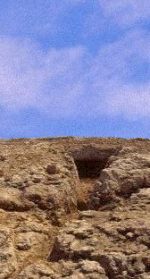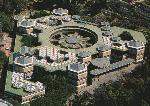 |
 |
|
|
|
THAPSOS
A plundered peninsula
|
| by Maccarrone Salvo
|
|
PRUDENCE: The Stones Of THAPSOS are by now in the Bottom of the sea |
|
 We immediately clarify: who is to the search of sumptuous temples or buildings ancient changes suffered rout because he/she would remain
disappointed. On this peninsula, silent interpreter of the anguish and the disturbance of the
priolesis, the ruins have disappeared even. Every palm of his/her plundered body and shattered it expresses
pain, suffering, torment.There is not that divine verticality of temples, of statues, of walls and of ancient buildings: it misses the hallucinatory presence of the ancient erected stone, that so much upsets the mind of some categories of
tourists. Quite a lot of its ancient stones are after all by now to the sea, confused among the cement of the offshore dike of the neighbor I bring of
August. And with his/her limbs, partly swallowed by that sea that you/he/she had fed her, every fluorescent trace of its bright Civilization disappeared budded during the Average Age of the Sicilian Bronze under the influence of the Civilization of Micene, that ancient city of the Argolide (Peloponneso), glorified by Humerus which I reign of the legendary Atreos and Agamennone and from himself qualified with a series of epithets:
city "regal", "rich of gold", dear to Giunione", city "from the wide roads", city "stately in his/her boundaries.
A fame that belonged only to Micene in the heroic period since it as Thapsos, were inexorably overwhelmed also and diruta to be arrived of new people. We immediately clarify: who is to the search of sumptuous temples or buildings ancient changes suffered rout because he/she would remain
disappointed. On this peninsula, silent interpreter of the anguish and the disturbance of the
priolesis, the ruins have disappeared even. Every palm of his/her plundered body and shattered it expresses
pain, suffering, torment.There is not that divine verticality of temples, of statues, of walls and of ancient buildings: it misses the hallucinatory presence of the ancient erected stone, that so much upsets the mind of some categories of
tourists. Quite a lot of its ancient stones are after all by now to the sea, confused among the cement of the offshore dike of the neighbor I bring of
August. And with his/her limbs, partly swallowed by that sea that you/he/she had fed her, every fluorescent trace of its bright Civilization disappeared budded during the Average Age of the Sicilian Bronze under the influence of the Civilization of Micene, that ancient city of the Argolide (Peloponneso), glorified by Humerus which I reign of the legendary Atreos and Agamennone and from himself qualified with a series of epithets:
city "regal", "rich of gold", dear to Giunione", city "from the wide roads", city "stately in his/her boundaries.
A fame that belonged only to Micene in the heroic period since it as Thapsos, were inexorably overwhelmed also and diruta to be arrived of new people.
|
|
BECAUSE' THEN AN ITINERARY ON THE PENINSULA OF MAGNISI?
|
|
 On the Peninsula of Magnisi the millennial history of Thapsos, that is then a meaningful shred of history of the basin of the Mediterranean, is written where in the sides of the leaning rocky walls toward the sea and in the ground, with skilled skill, you/they were dug in the alive rock hundreds of magnificent graves to "tholos", still today inexhaustible deposits of sumptuous funeral outfits to a large extent of clear origin egeo-micenea, and in the others more you mutilate archaeological finds (what today they introduce serious problems of maintenance), affioranti from the ground of good part of the Peninsula of Magnisi.
These last finds belong to the ancient city of Thapsos, held by the most greater part of the researchers "perhaps the most ancient real city founded by the Miceneis in Italy, or at least from them developed on a preexisting native installation" (Claudio De
Palma, La Magna Grecia, Newton Compton publishers, May 1980, pag.29).
The city, to judge from the archaeological wise man, was provided of "fortifications megalitiche.
"His/her fortifications megalitiches from a side recall those continental and insular micenees (Kalandriani to Syros) and colonial of west (Los Millares in Iberia), from the other one they are perpetuated in the following centuries in the royal building (anàktoron) megalitico of Pantalica north (XIII-XII sec.a.C), also of clear influence miceneo" (Claudio De
Palma, ibid.) On the Peninsula of Magnisi the millennial history of Thapsos, that is then a meaningful shred of history of the basin of the Mediterranean, is written where in the sides of the leaning rocky walls toward the sea and in the ground, with skilled skill, you/they were dug in the alive rock hundreds of magnificent graves to "tholos", still today inexhaustible deposits of sumptuous funeral outfits to a large extent of clear origin egeo-micenea, and in the others more you mutilate archaeological finds (what today they introduce serious problems of maintenance), affioranti from the ground of good part of the Peninsula of Magnisi.
These last finds belong to the ancient city of Thapsos, held by the most greater part of the researchers "perhaps the most ancient real city founded by the Miceneis in Italy, or at least from them developed on a preexisting native installation" (Claudio De
Palma, La Magna Grecia, Newton Compton publishers, May 1980, pag.29).
The city, to judge from the archaeological wise man, was provided of "fortifications megalitiche.
"His/her fortifications megalitiches from a side recall those continental and insular micenees (Kalandriani to Syros) and colonial of west (Los Millares in Iberia), from the other one they are perpetuated in the following centuries in the royal building (anàktoron) megalitico of Pantalica north (XIII-XII sec.a.C), also of clear influence miceneo" (Claudio De
Palma, ibid.)
|
|
THE FIRST EXPLORATIONS OF THE SITE
|
|
 The first explorations of the site, after the descriptions of foreign travellers on the so many "caves" existing along the oriental coast of the Peninsula of Magnisi, they had only beginning in 1880 to work of the archaeologist Saverio Cavallari.
Subsequently the first and more intense secret of Thapsos were revealed dall to the world' untiring work of a young archaeologist roveretano, Paul Orsi (in the photo), that, in the turn of an inclusive shine between 1890 and 1895, it attentively examined different necropolises of the siracusano assembling its attention on the Peninsula of Magnisi.
The results from him achieved were enough satisfactory and, slowly, the radiant Civilization of Thapsos returned to way of living through the first splendid materials that the bears it extracted from the bowel of the earth, coming from rich funeral outfits and that they understood ceramic micenee, long swords in bronze and objects of ornament, to a large extent imported by the area egea between the XV and the XIII century a.C.
From the analysis of this sensational loot and some works in masonry, you individualize in the hallway of some grave to "tholos", Paul Orsi realized the notable cultural and commercial relationships intervened in the Average Age of the Sicilian Bronze between Thapsos and the world miceneo. The first explorations of the site, after the descriptions of foreign travellers on the so many "caves" existing along the oriental coast of the Peninsula of Magnisi, they had only beginning in 1880 to work of the archaeologist Saverio Cavallari.
Subsequently the first and more intense secret of Thapsos were revealed dall to the world' untiring work of a young archaeologist roveretano, Paul Orsi (in the photo), that, in the turn of an inclusive shine between 1890 and 1895, it attentively examined different necropolises of the siracusano assembling its attention on the Peninsula of Magnisi.
The results from him achieved were enough satisfactory and, slowly, the radiant Civilization of Thapsos returned to way of living through the first splendid materials that the bears it extracted from the bowel of the earth, coming from rich funeral outfits and that they understood ceramic micenee, long swords in bronze and objects of ornament, to a large extent imported by the area egea between the XV and the XIII century a.C.
From the analysis of this sensational loot and some works in masonry, you individualize in the hallway of some grave to "tholos", Paul Orsi realized the notable cultural and commercial relationships intervened in the Average Age of the Sicilian Bronze between Thapsos and the world miceneo.
|
|
THE OTHER EXPLORATIONS
|
|
 Further investigations performed on almost the whole area of the peninsula of Magnisi by Joseph Voza, have widened since then the knowledges up to culminate, at the end of the sixties, in the extraordinary discovery of traces of the ancient inhabited area of Thapsos and a particular housing nucleus to the center of it, protected from a mighty building structure that he/she remembers, in unequivocal way, the typical architecture micenea (in the photo the suggestive one "Hands some lions" to Micene).
Insofar any object recovered in the zone of the inhabited area has been, and it is anchor, submitted to careful analysis.
And who knows if from this "questioning" those stones, that containers of alimentary commodities, that china of common use and also that rests of meals, don't decide one day of "to speak", telling us so the rest of this fascinating history. Further investigations performed on almost the whole area of the peninsula of Magnisi by Joseph Voza, have widened since then the knowledges up to culminate, at the end of the sixties, in the extraordinary discovery of traces of the ancient inhabited area of Thapsos and a particular housing nucleus to the center of it, protected from a mighty building structure that he/she remembers, in unequivocal way, the typical architecture micenea (in the photo the suggestive one "Hands some lions" to Micene).
Insofar any object recovered in the zone of the inhabited area has been, and it is anchor, submitted to careful analysis.
And who knows if from this "questioning" those stones, that containers of alimentary commodities, that china of common use and also that rests of meals, don't decide one day of "to speak", telling us so the rest of this fascinating history.
|
|
THE MAGIC OF THE WILD ASPECT AND WITHOUT TIME
|
|
The manifold documents of civilization (cult of the corpses, architectural ability, originality in the forms of the ceramics, dynamism in the commercial exchanges, functionality of the buildings), harmonized by the magic of the wild aspect today and almost without time, they make the whole peninsula irresistible place of call for so much people (archaeologists, studious, naturalists, ecologists, poets, solitary, persons' in love couples, groups of curious and scolaresche).
All in love people of this place and with an innate desire to stir, to cross new cultural frontiers, of conocere the most authentic values of this very maltreated archaeological, environmental, cultural and human patrimony; people that, after having understood the extraordinary peculiarities of the peninsula priolese, you/he/she has learned to respect her/it and to love her/it.
|
|
EXCITING THE TURN IN BOAT
|
|
Another irresistible and exciting call is the turn of the peninsula in boat, since it allows the immediate knowledge of its low coasts and the rediscovery of those numerous graves that open along the oriental rocky crags and hardly visitable with an excursus afoot.
Besides from the sea it is easier to observe some capricious and suggestive forms of the rocks of Magnisi, carved by the slow but inexorable erosion of the waves of the sea.
|
|
ALL THE FINDS RECOVERED ON THE PENINSULA OF MAGNISI SONO EXPOSED IN THE REGIONAL ARCHAEOLOGICAL MUSEUM "PAUL ORSI" OF SYRACUSE
|
|
 Currently, not being you fit structures to Priolo, all the archaeological finds recovered on the Peninsula of Magnisi/Thapsos, they enrich the collections exposed in the so many showcases of the sector of the prehistory and protostoria of the Regional Archaeological Museum "Paul Orsi" of Syracuse (sector Á.), where her "Culture of Thapsos" it is among the most documented.
The Museum is situated in Syracuse in avenue Teocrito, 66 (tel.
0931/464022) and it is open to the public only five days the week, from the 9 at 13 o'clock (he/she is closed the Sunday and the Monday).
8.000 liras it is the ticket of entry; entered free instead for the smaller ones of 18 years, for the ultra sessantennis and for the scolaresches (this last however they have to book the visit); entered facilitated to the carriers of handicap. Currently, not being you fit structures to Priolo, all the archaeological finds recovered on the Peninsula of Magnisi/Thapsos, they enrich the collections exposed in the so many showcases of the sector of the prehistory and protostoria of the Regional Archaeological Museum "Paul Orsi" of Syracuse (sector Á.), where her "Culture of Thapsos" it is among the most documented.
The Museum is situated in Syracuse in avenue Teocrito, 66 (tel.
0931/464022) and it is open to the public only five days the week, from the 9 at 13 o'clock (he/she is closed the Sunday and the Monday).
8.000 liras it is the ticket of entry; entered free instead for the smaller ones of 18 years, for the ultra sessantennis and for the scolaresches (this last however they have to book the visit); entered facilitated to the carriers of handicap.
|
|
|
|

